Clash of the Titans - TT Tai Chi vs. CM Stacker 830
by Joshua Buss on February 23, 2006 12:05 AM EST- Posted in
- Cases/Cooling/PSUs
Thermaltake Tai Chi
Thermaltake knows how to make a good case. This has been shown to be true time and time again both by our site and many others. A subdivision of theirs, Thermalrock, ran away with a gold editor's choice award in our large 8-way comparison for its excellent Eclipse case, and although never published, a close examination of their Armor case also bore out this claim as it is a fine unit capable of just about anything that one could ever want in a computer case. So, how does one improve upon cases as nice as the Armor and Eclipse, exactly? Well for starters, you don't remove any of the features that made the predecessors so popular.
Like the armor, the most prominent feature of the Tai Chi is the staggering number of externally available 5¼” drive bays – 11 to be exact. While there is one bay that's already assumed used for the 3½” drive/ power+reset buttons/LED indicators unit, it's still technically optional, as is the accessory tray and hard drive cage. Even with all three of these units in place, however, the Tai Chi could hold any of the following possible configurations: an additional six 5¼” drives; three 5¼” drives and an additional three hard drives; or two more hard drive cages for a total of nine hard drives. The storage options alone will be reason enough for some people to jump right on this unit. With this much capacity comes a price – and that price is size. The Tai Chi is massive.
Getting past the amazing drive capacity and size is just the beginning, however; the Thermaltake flagship case doesn't look like a giant radiator for nothing. Solid 1/8” think aluminum panels lining both sides absorb much of the computer's excess heat and passively vent it to the surrounding air.
The right side of the case, being almost entirely void of anything interesting, is even more monolithic in appearance than the left. To break up the monotony and give the case its own flair, Thermaltake uses two overlapping flaps to conceal the front drives.
The inner flap is anodized black, and when partially covered by the silver flap, helps to spice up the otherwise all-silver look and give the case a very stylish curved theme when viewed from the front. Besides simply looking cool, these over-sized half-doors should provide some decent protection considering their thickness, something that we questioned with the Armor's “flaps”. In addition to beefy door panels, the Tai Chi comes with two solid aluminum handles to help move the beast around, which are not even really optional anymore on a case this size. Nonetheless, they are a well-executed addition, and are completely removable if desired.
Here, we can take a closer look at the actual finish of the Tai Chi and the layout of the top of the unit. Notice how the paint job actually leaves the aluminum with a metallic speckled look. The pictures don't even really do it justice, as it almost comes across as a brilliant platinum more so than a normal silver anodization. The port cluster for the Tai Chi is on top, and unfortunately, it places all the ports very close to each other, but that's starting to become less and less of a problem as USB devices continue to shrink. With the USB, FireWire, and audio jacks so far back on the top of the unit, Thermaltake was locking themselves into users placing this case on the ground, but with a case this large, we don't think that many users would object to this restraint – this case would simply look out of place on top of most desks.
The left side of the Tai Chi is all business. Massive holes open the warmest area of the interior completely to the outside, while large aluminum fins do the rest of the work in terms of whisking away heat from the computer. The various visible screws are what hold the three individual panels in place, but can be taken out if work needs to be done on any panel.
Thermaltake knows how to make a good case. This has been shown to be true time and time again both by our site and many others. A subdivision of theirs, Thermalrock, ran away with a gold editor's choice award in our large 8-way comparison for its excellent Eclipse case, and although never published, a close examination of their Armor case also bore out this claim as it is a fine unit capable of just about anything that one could ever want in a computer case. So, how does one improve upon cases as nice as the Armor and Eclipse, exactly? Well for starters, you don't remove any of the features that made the predecessors so popular.
Like the armor, the most prominent feature of the Tai Chi is the staggering number of externally available 5¼” drive bays – 11 to be exact. While there is one bay that's already assumed used for the 3½” drive/ power+reset buttons/LED indicators unit, it's still technically optional, as is the accessory tray and hard drive cage. Even with all three of these units in place, however, the Tai Chi could hold any of the following possible configurations: an additional six 5¼” drives; three 5¼” drives and an additional three hard drives; or two more hard drive cages for a total of nine hard drives. The storage options alone will be reason enough for some people to jump right on this unit. With this much capacity comes a price – and that price is size. The Tai Chi is massive.
Getting past the amazing drive capacity and size is just the beginning, however; the Thermaltake flagship case doesn't look like a giant radiator for nothing. Solid 1/8” think aluminum panels lining both sides absorb much of the computer's excess heat and passively vent it to the surrounding air.
The right side of the case, being almost entirely void of anything interesting, is even more monolithic in appearance than the left. To break up the monotony and give the case its own flair, Thermaltake uses two overlapping flaps to conceal the front drives.
The inner flap is anodized black, and when partially covered by the silver flap, helps to spice up the otherwise all-silver look and give the case a very stylish curved theme when viewed from the front. Besides simply looking cool, these over-sized half-doors should provide some decent protection considering their thickness, something that we questioned with the Armor's “flaps”. In addition to beefy door panels, the Tai Chi comes with two solid aluminum handles to help move the beast around, which are not even really optional anymore on a case this size. Nonetheless, they are a well-executed addition, and are completely removable if desired.
Here, we can take a closer look at the actual finish of the Tai Chi and the layout of the top of the unit. Notice how the paint job actually leaves the aluminum with a metallic speckled look. The pictures don't even really do it justice, as it almost comes across as a brilliant platinum more so than a normal silver anodization. The port cluster for the Tai Chi is on top, and unfortunately, it places all the ports very close to each other, but that's starting to become less and less of a problem as USB devices continue to shrink. With the USB, FireWire, and audio jacks so far back on the top of the unit, Thermaltake was locking themselves into users placing this case on the ground, but with a case this large, we don't think that many users would object to this restraint – this case would simply look out of place on top of most desks.
The left side of the Tai Chi is all business. Massive holes open the warmest area of the interior completely to the outside, while large aluminum fins do the rest of the work in terms of whisking away heat from the computer. The various visible screws are what hold the three individual panels in place, but can be taken out if work needs to be done on any panel.


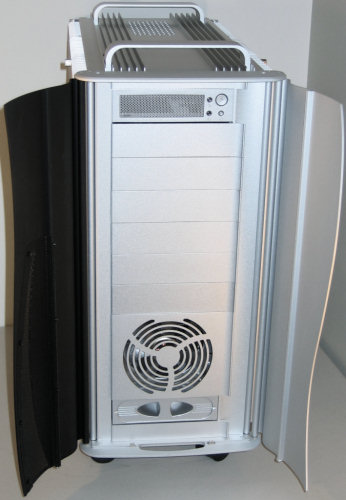
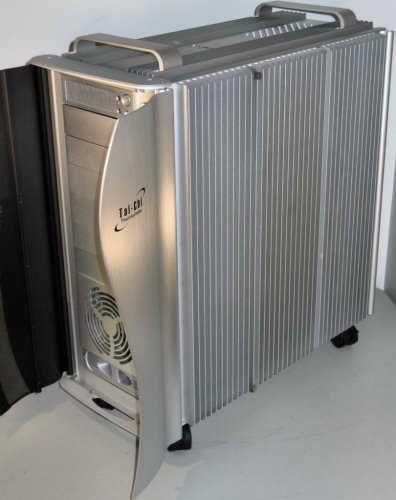
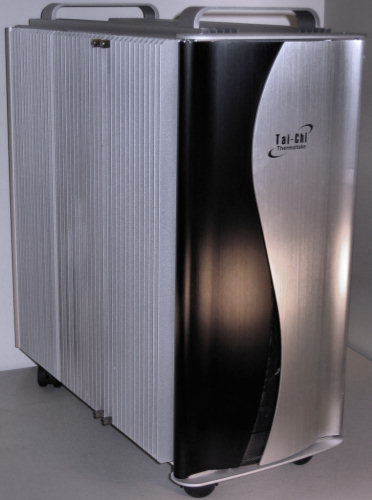
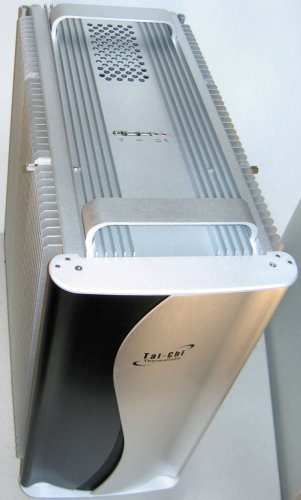
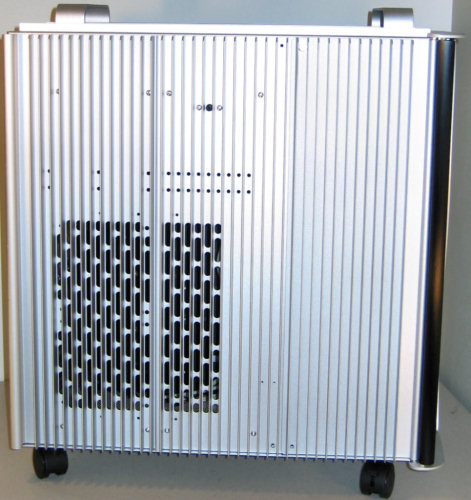








55 Comments
View All Comments
chynn - Thursday, March 2, 2006 - link
Yes, you can. I'm surprised AnandTech missed that option in their review. I like mounting inverted (BTX-style) ATX motherboards because that points the HSFs on my graphics cards (I run SLI) up to help dissipate heat.Googer - Thursday, February 23, 2006 - link
let me rephrase that.Is it possible invert the motherboard on the CM Stacker by installing the tray on the left side in place of the usual right side
By inverting the motherboard (insalling on the BTX side) it may allow for better CPU cooling sine the processor would be sitting on the bottome getting plenty of cool air and allowing hot exhaust to escape upwards.
kextyn - Friday, February 24, 2006 - link
I believe it would depend on which CM Stacker you get. I have the original and I run my ATX motherboard inverted on the opposite side just for this reason (cooling.) Also because I have an XP-120 on the CPU and don't have to worry about clearance issues with the PSU.If you're going to buy a Stacker I suggest looking at the specs on all of them before deciding. If I was going to buy another one I'd get the original again. It offers the full 12 5.25" bays in the front, dual PSU's, ATX/BTX/Inverted ATX/Inverted BTX, and I think more mod potential than this new one. The reason is because it's so basic that you can just cut and add stuff wherever you want. The only thing I like about this new one is that 4x120mm fan array on the side. But if I really wanted to I could mod the side of my case for that.
Googer - Thursday, February 23, 2006 - link
Also will a PC Power and Cooling Turbo Cool 850 or any other oversized PSU fit in to either the Thermaltake or Cooler Master?chynn - Thursday, March 2, 2006 - link
Yes, the PCP&C 850W PSU should fit in the Stacker. You might have to orient the PSU so the cables exit from the bottom side to clear the 120mm fan in the top center, but the Stacker will let you do that.Matthews316 - Thursday, February 23, 2006 - link
I own the Thai-Chi, and my PC Power and Cooling 1 KW (same size as the 850) fits just fine. I heard a rumor that oversized PSU's, such as the PCP&C 850/1KW, won't fit in the CM Stacker 830. Can anyone comment on this?JoshuaBuss - Thursday, February 23, 2006 - link
I would say that as long as there's nothing protruding from the sides, top, or bottom of the PSU, it'll fit in the stacker fine... length isn't the issue, it's the sides, top, and bottom you'd have to watch carefully.Googer - Thursday, February 23, 2006 - link
What a tough decision it would be to choose between those two cases, both are feature rich and well though out and designed. (if price was not a concern)yanquii - Thursday, February 23, 2006 - link
I love seeing case reviews on this site, especially considering how sparsely they are reviewed. What I would like to see are some reviews done on some cases that don't look like they came off they toy isle from the nearest Dollar General store. It would be sweet if you guys could do some reviews on the higher end offerings from Silverstone; especially the TJ07.yanquii - Thursday, February 23, 2006 - link
oh, and Lian-Li. I remember when Coolermaster was pumping out the sweetest cases you could buy. I love simplicity and elegance, and it seems that most companies are all about gaudy flash.